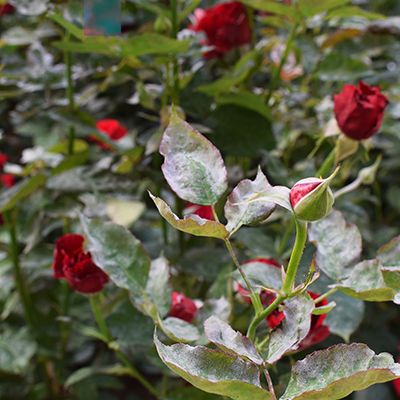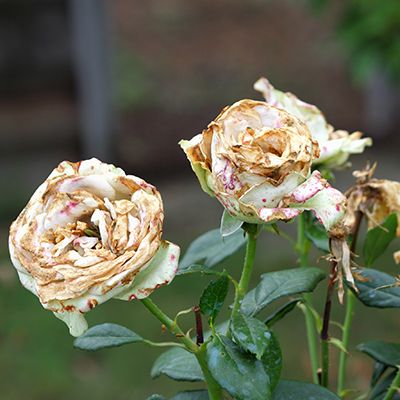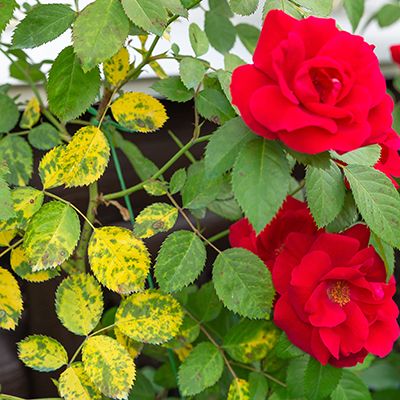


Treating Common Rose Diseases
The three most common rose diseases are powdery mildew, rust and black spot. Rose diseases are best prevented by providing a favorable cultural environment for the roses. Shade and moderate temperatures favor most rose diseases, so locate plants in sunny areas as much as possible and plant the bushes at least four feet apart to provide good air circulation. Avoid high Nitrogen fertilizers. A dormant spray of six tablespoons of Master Nursery® Year Round Spray Oil (Horticultural Oil) mixed with two tablespoons of Monterey Liqui-Cop® per gallon of water applied immediately after pruning will help prevent early appearance of these diseases. One tablespoon of Monterey Liqui-Cop® mixed with four tablespoons of the Master Nursery® Year Round Spray Oil in one gallon of water, applied monthly, will act as a preventive and eradicant for these diseases. Be sure to check instructions on the containers. Never apply Horticultural Oil (or any oil spray) to water stressed plants or when the temperatures will be 85˚F or greater. Likewise, do not spray plants with oil spray or with sulfur within one month of each other.
Fungicides fall into two broad categories; preventives and eradicants. Most rose fungicides are preventive and must be applied before the plant becomes infected and will prevent new infections from occurring. An eradicant can kill an existing infection.
Powdery mildew is the most common fungus disease of roses. It appears as a white to gray powder coating upper, leaf surfaces. In severe cases it will also be found on lower leaf surfaces and coating emerging flower buds. Initially, it can be rubbed off between the thumb and fore finger but soon reappears. It can be prevented if Safer® Garden Fungicide or a mixture of Monterey Liqui-Cop® (one tablespoon per gallon of water) and Master Nursery® Year Round Spray Oil (four tablespoons per gallon of water) is sprayed and covers the plant to dripping before the plant shows symptoms of the disease. Copper sprays with less than 25% Copper are of little value. A mixture of Monterey Liqui-Cop® at one tablespoon per gallon, plus Master Nursery® Year Round Spray Oil at five tablespoons per gallon H20 and Bonide® Fung-onil ™ (Chlorothalonil) are used as preventives and eradicants. The spread of powdery mildew will be reduced when the plants receive an overhead water spray. The water washes off the spores from the mildew and when spores land in water, they die. Irrigate in mid-morning so plants dry rapidly and reduce the likelihood of other fungus infections such as black spot or rust.
As part of its Pest Management Program, the UC Department of Agriculture and Natural Resources has stated, “several least-toxic fungicides are available including horticultural oils (Year Round Spray Oil, Neem Oil, Jojoba Oil) sulfur, potassium carbonate and the biological fungicide, Serenade. With the exception of the oils, these materials are primarily preventive. Oils work best as eradicants, but also have some protective activity”.
A black spot appears as circular black spots circled in yellow and only on upper leaf surfaces. The spots may coalesce to form large spots which do not penetrate the leaf. Black spot is spread by splashing water. It becomes less of a problem as our weather becomes warm and dry. Overhead watering is to be avoided except as mentioned above. Badly and moderately infected leaves should be removed and discarded. Do not compost.
Rust initially appears as tiny black spots on the top and bottom of a leaf. As the spots enlarge they become rust colored and finally black. The rust pustule penetrates both upper and lower leaf surfaces until the entire leaf is yellow and drops off. Rust fungus is a midseason disease and can defoliate a plant. Monterey Liqui-Cop® and Safer® Garden Fungicide are effective preventives. Pick off and discard severely infected leaves. Reapply the chemicals as new leaves appear. Master Nursery® Year Round Spray Oil or Neem Oil will also act as an eradicant. Bonide® Fung-onil™ is effective as an eradicant and preventives for mildew, black spot and rust on roses. Be sure to check instructions on the containers.
Stem cankers may appear on the canes of roses. They are indentations parallel to the stem ranging from one-half inch to three or four inches long. They are caused by a fungus and can kill the stem. There is no cure so the treatment is to cut the cane four to six inches below the canker and dispose of it. Do not compost.
Viruses may appear on roses, usually on bushes sold ten or more years ago. Most commonly they appear on new spring foliage, stressed plants or at the end of the growing season. At least two different kinds of viruses could infect roses. One form leaves zig-zag lines that resemble lightning bolts. The other produces yellow circles on the green leaves; these virus symptoms may temporarily disappear when the plant is actively growing. Both viruses may produce a slight stunting of growth but will do no other harm. They are spread by grafting a healthy cutting to a diseased rootstock or a diseased cutting to a healthy rootstock. The virus becomes systemic in the plant and remains there for the life of the plant. There is no cure or remedy.
For further information, see UC ANR Publication 7493: Pest Notes “Powdery Mildew on Ornamentals”.